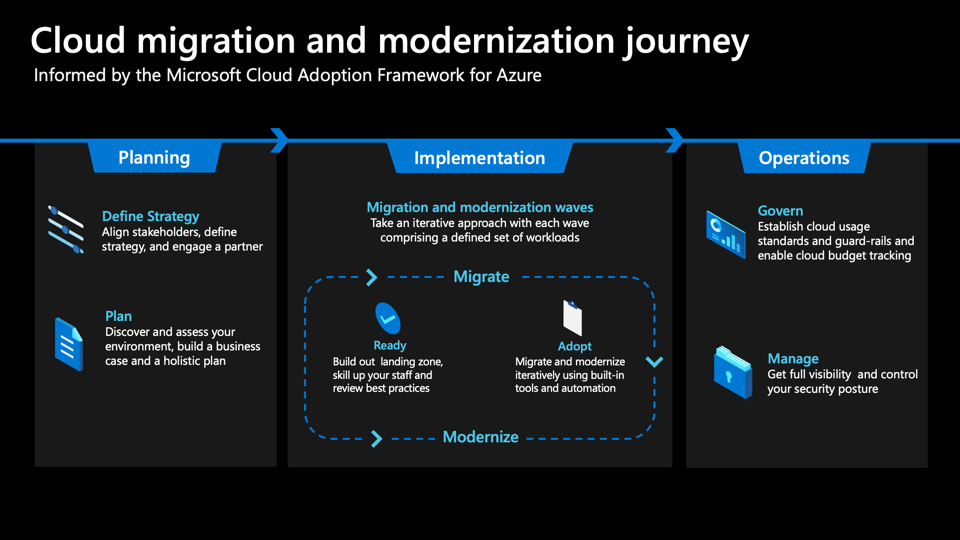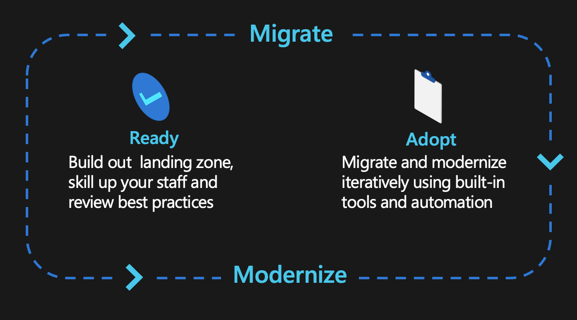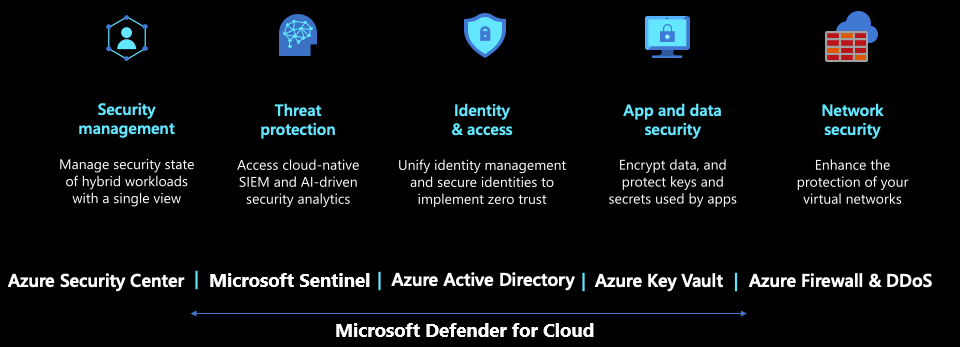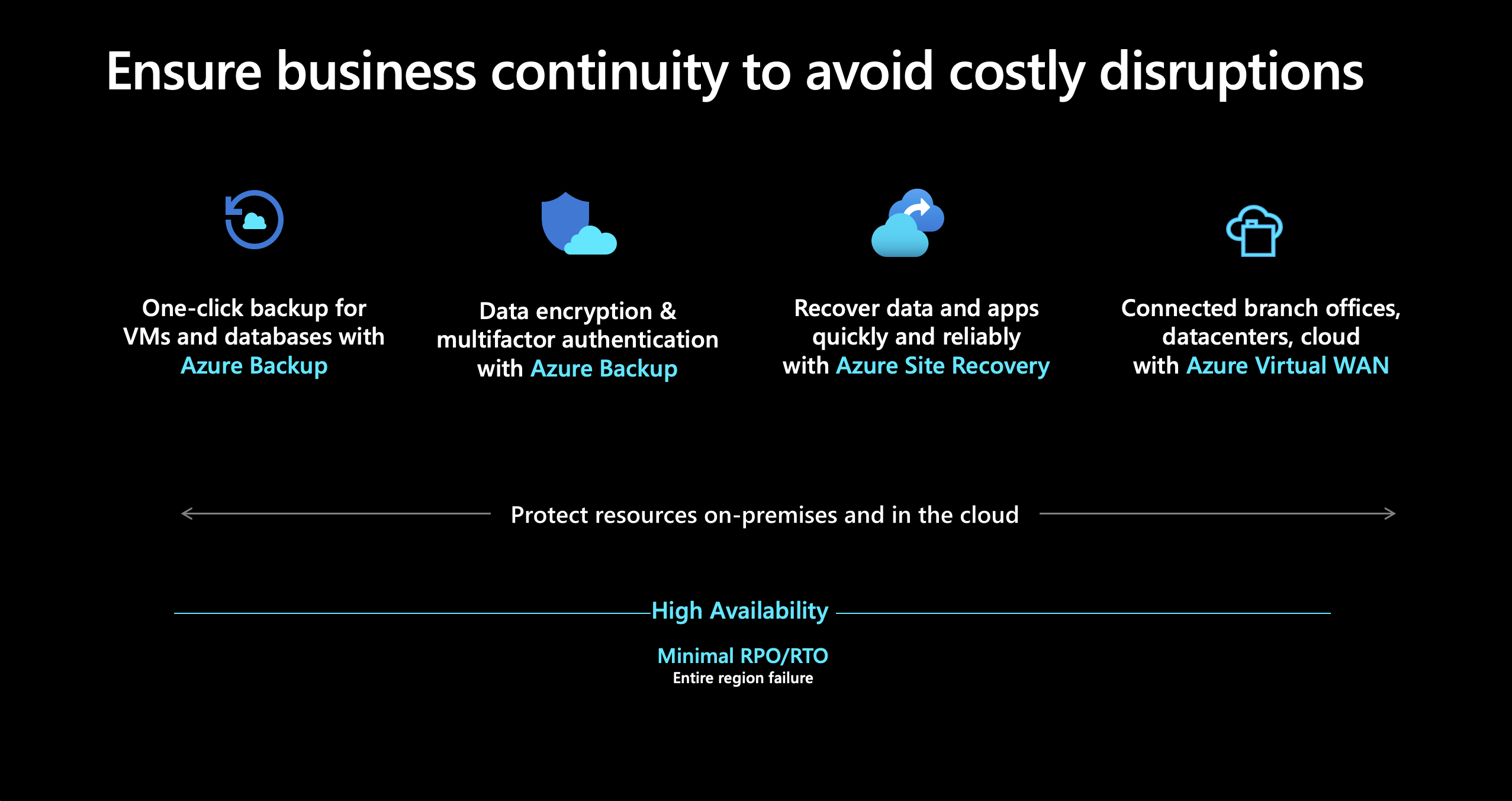Cloud journey phases
Cloud migration and modernization involve organizational change management that spans people, process, and technology. Taking a holistic approach helps you navigate the journey successfully and ensure that your organization realizes new benefits, including efficiency, agility, and scale, once your workload runs in the cloud.
The phases of your migration journey at Tailwind Traders include:
- Planning
- Implementation
- Operations

Important
The Cloud Adoption Framework is a collection of documentation, implementation guidance, best practices, and tools from Microsoft that are proven to accelerate your cloud adoption journey.
Planning
Planning sets the stage for a successful migration to the cloud. During planning, two activities must be completed:
- Define strategy
- Plan
Define strategy
Defining the strategy is an important first step in any migration and modernization project. Defining the strategy can be broken down into three steps:
- Stakeholder alignment
- Define a strategy
- Engage a partner
Stakeholder alignment
To avoid common migration blockers, create a clear and concise business strategy for migration. Stakeholder alignment on motivations and expected business outcomes shape decisions made by the cloud adoption team. Involving key stakeholders facilitates a smoother, faster migration that meets organizational goals by enlisting the broad support of a cross-functional team made up of IT, finance, and business owners.
- Motivations: The first step to strategic alignment is to gain agreement on the motivations that drive the migration effort. Start by understanding and categorizing motivations and common themes from various stakeholders across business and IT.
- Business outcomes: After motivations are aligned, it's possible to capture the desired business outcomes. This information provides clear metrics you can use to measure the overall transformation.
Define a strategy
Defining a strategy for a move to the cloud is an important beginning step in the process. Proper strategic planning, done early, sets a guide for the migration and modernization of on-premises workloads to the cloud.
This is accomplished by creating a cloud strategy team. This team is responsible for the planning of the move to Azure. They define motivations and business outcomes and then validate and maintain alignment between the business priorities and cloud adoption efforts.
Engage a partner
The migration and modernization process often requires a deep understanding of Azure in order to ensure a smooth a successful migration. Engaging a partner early in the process provides the ability to leverage their deep domain expertise both in the planning and execution of the move.
By engaging a partner in the planning process, potential pitfalls can be avoided in the migration and modernization journey because they have the experience to drive the move forward along the correct path.
Plan
Once a strategy is defined, it's time to start planning the move. As with defining the strategy, planning can be broken down into three steps:
- Discover and assess
- Business case
- Holistic plan
Discover and assess
Use discovery and assessment to improve technical alignment and create an action plan for executing your strategy. During this step, validate the business case using data about the current state environment. Then perform quantitative analysis and an in-depth qualitative assessment of the highest priority workloads.
You need to discover and assess your apps, databases, and infrastructure. Build an inventory of your infrastructure, assess your on-premises environments, get right-sizing guidance, workload-level cost estimates, and performance metrics. Azure Migrate can be used to build this inventory. You can also gain insights into your dependencies, such as which web servers connect to your database servers.
Business case
Making the business case for migration and modernization is likely to be an iterative conversation among stakeholders. In this first pass at building the business case, evaluate the initial high-level return from a potential cloud migration. The goal of this step is to ensure that all stakeholders align around one simple question: based on the available data, is the overall adoption of the cloud a wise business decision?
- Building a cloud migration business case is a good starting point for developing a migration business case. Clarity on formulas and tools can aid in business justification.
At the highest level, the formula for business justification is simple. But the subtle data points required to populate the formula can be difficult to align. On a basic level, the business justification focuses on the return on investment (ROI) associated with the proposed technical change. The generic formula for ROI is:

Holistic plan
With this information in hand, your cloud migration Center of Excellence (CoE) team can now build a holistic migration plan. Account for workload priorities, timelines, milestones, resources, and funding. Determine if each application should be migrated or modernized. Define your approach based on three considerations: migration triggers, business goals, and workload priorities. Migrate if you have time-sensitive triggers. Modernize for targeted and business-critical workloads that will see continued investment.
Next, break up your overall plan into migration waves, each with a group of related workloads. Get buy-in from leadership and your new migration center of excellence.
Implementation
Executing on the plan is where the act of moving to the cloud starts to unfold. Three main work-streams take place during the execution phase of an Azure migration:
- Building cloud skills
- Landing zone
- Migration
Migration and modernization waves
During the move to the cloud, use a wave-based approach to execute a manageable set of workloads. Migrate and modernize in waves with an iterative approach. Pick a manageable-sized cohort of workloads for each wave and perform the move using automated tools. Select the target cloud services to move your workloads into, like Azure IaaS for infrastructure or Azure App Service for web apps.

Building cloud skills
Existing employees can play a hands-on role in the migration and modernization effort, but additional skills might be required. In this step, find ways to develop those skills or use partners to add to those skills. Get your IT and app development teams up to speed on cloud technologies, migration tools, and operational processes. Upfront training investment helps you to scale your migration efforts more efficiently and set up your organization for success.
Ensure your teams are ready and skilled up on Azure fundamentals and workload-level considerations. For example: If you're migrating virtual machines, your IT teams need to be well versed in Azure IaaS capabilities and how to operate them once they get here. Same for databases and apps.
Build a skills-readiness plan. Quickly evaluate your existing skills to identify what other skills the team should develop.
Landing zone
To migrate your applications and create the new modernized versions, you first need to set up a landing zone. A landing zone is an environment deployed to Azure that's ready to host your workloads. Pre-configured landing zones include networking, identity, management, security, and governance elements that balance agility with organizational standards. By using landing zone best practices, you avoid governance issues during and after migration.
Choose a landing zone: Find the right approach to deploying a landing zone based on your adoption pattern. Then deploy that standardized codebase.
Expand your landing zone: Whatever your starting point, identify gaps in the deployed landing zone and add required components for resource organization, security, governance, compliance, and operations.
Migration and modernization
The Azure Migration and Modernization Program (AMMP) has determined that projects with six to eight applications in a wave enjoy the most success. This approach lets teams work in a focused manner, thereby increasing the quality of migration and modernization, and it allows improvements along the way. This program also helps assess and plan which workloads can be modernized, and the process to accomplish it.
Operations
Operations management is another requirement to reach migration and modernization success. Moving individual workloads to the cloud without an understanding of ongoing enterprise operations is a risky decision. In parallel with the shift to the cloud, you should start planning for longer-term operations.
The preceding steps create actionable approaches to deliver on the Cloud Adoption Framework's Manage methodology.

Governance
Governance is a key factor to the long-term success of any effort. The speed to complete the move and business impact is important, but speed without governance can be dangerous. Your organization needs to make decisions about governance that align to your adoption patterns and your governance and compliance needs.
- Governance approach: This methodology outlines a process for thinking about your corporate policy and processes. After determining your approach, you can build the disciplines required to enable governance across your enterprise cloud adoption efforts.
Azure Policy
Azure Policy is an important tool when implementing the policies of your business. Azure Policy helps to enforce organizational standards and to assess compliance at-scale. Through its compliance dashboard, it provides an aggregated view to evaluate the overall state of the environment, with the ability to drill down to the per-resource, per-policy granularity. It also helps to bring your resources to compliance through bulk remediation for existing resources and automatic remediation for new resources.

Manage
Putting the proper foundation down for moving to the cloud is critical. However, continued management and maintenance of the environment is also important to keep things running smoothly. Migrating to the cloud and modernizing your workloads requires a shift when it comes to managing the cloud resources
Security
Once workloads have been moved into the cloud, Microsoft Defender for Cloud can help manage security for these applications. This protection can be provided at the network level using Azure Firewall, the identity level in Microsoft Entra ID, or by sending alerts of particular activities with Microsoft Sentinel.

Business continuity
Business continuity is still important to Tailwind Traders after the migration and modernization process, both for applications that have been moved to the cloud and applications that still exist on-premises. Insuring that Azure resources have backups in place and can be recovered when needed.
By moving their applications to Azure, Tailwind Traders is able to manage their end-to-end business continuity solution both in the cloud and on-premises in an easy to deploy, cost-effective, secure, and scalable manner.
